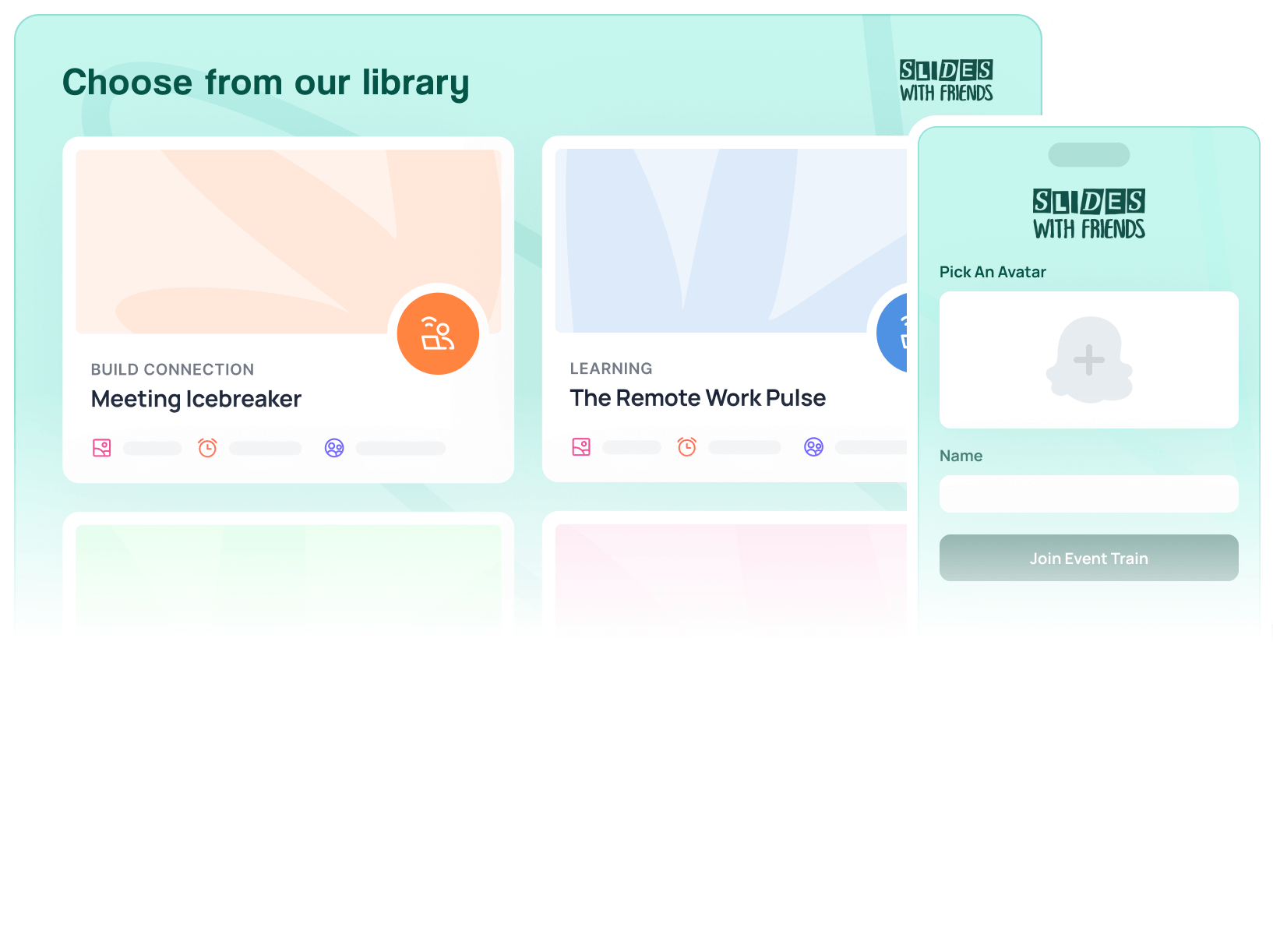The 60+ Best Virtual Icebreaker Questions and How to Use Them
The best icebreakers can really open up a meeting and get your audience in the right mood. Learn how and when to use icebreakers, the different types, and a list of some all-star questions.
Meetings can be long and personally draining in the best of times. If you're working with remote teams, it gets even harder. It's a psychological truth that video calls are more difficult to interact in than in-person events. There's a lot of science on why video calls are so tiring, from monologuing to self-gazing to mis-synchronizing:
"Eye contact plays a documented role in successful human communication.”
Christina Cauterucci, Slate
But most of us don't need the peer review to know what we already have experienced: the end-of-day Zoom-blues.

The two most important things to do:
Not all icebreaker questions are created equal, and not all fun icebreaker questions should be asked the same way. Here's the two things to know about these team building activities:
- Make sure the ice breakers you're asking are positive, ie, that they'll prompt people to communicate in a pro-social way while also feeling good about themselves.
- Give everyone in the group a voice: whether it's through tools like the Zoom chat or formats like "raise your hand if," make sure to hear from everyone and to make space for the quiet folks. If you're got a larger remote team or big audience, we have lots of icebreaker tools and tricks to help with this.
Without further ado, here are the best creative ice breaker questions to use with as simple team building activities with your remote teams, virtual meeting, conference audience, or group. Get ready for some team bonding!
Best Meeting Icebreakers (for mid to small groups)
How do you start off a meeting with each team member smiling? Sounds hard but if you break it down, it's the simplest thing: get them thinking about something that makes them smile.
Here are 20+ of the best ice breaker questions for virtual meetings. They all work great for virtual meetings, in-person meetings, virtual team building events, hybrid / remote team building, and in person team building.
- What's your favorite item you've bought this year?
- If you were famous, what would you be famous for?
- What's the best meal you can remember eating?
- What would be the best fictional world to live in?
- What's something nobody here knows about you?
- What's a book you loved as a kid that everyone should read?
- Who is your ultimate female role model?
- If we had an office talent show, what would be your talent?
- If money weren't an object, what would you do with your life?
- What's a fashion trend that you thought was not a great idea?
- TV show or podcast you're thrilled exists?
- What's your favorite ice cream flavor?
- What's a guilty pleasure of yours?
- Name your favorite breakfast food.
- What was your most embarrassing fashion trend as a teenager?
- On a desert island, what three books would you bring?
- What was your favorite childhood movie that you can't rewatch now?
- If you got a million dollars unexpectedly, what would you buy first?
- What's the worst thing about zoom icebreaker questions?
- What's the best part of your morning routine?
- What's your guilty pleasure favorite tv show that you wouldn't ever recommend to anyone else?
If you want to play a more official game (and look like you did a lot of work when you didn't 😉) here's couple simple, great icebreaker games you can play with your small to medium team before your next meeting! They're free to use with up to 10 players


Bonus, they've got built-in interaction so everyone can answer and play along, no matter where they are (or whether they're shy). All you need is a way to share your screen (like a zoom call or a tv / meeting room projector), and your team can join in and answer icebreaker questions as group, with their smartphones.
See more ready-to-play Icebreaker Games here if you want to choose a special game to get your whole team smiling and warm up the vibe of your meetings.
Best Happy Hour / Funny Icebreaker Questions (for mid to small groups)
Sometimes we just need to let loose and have fun. (We of course don't recommend this, work should be serious at all times! but there are those that say it's an important part of being human and connecting with one another.)
Here are 20 fun virtual ice breakers (they also work in person) for team bonding:
- What celebrity would play you in a movie?
- Tell a short story with just emoji.
- If we were doing karaoke, what song would you pick to sing?
- If you were the host of the Tonight Show, who would be your first celebrity guest?
- What's your favorite thing about quarantine?
- What was the coolest trend you rocked as a teenager?
- What did you want to be when you grew up?
- Who's your favorite Disney character?
- What breed of dog is our company?
- What's your phone lock screen?
- In the event of a zombie apocalypse, what item would you stuff in your "go bag" first?
- Compared to our other team members, I'm more _________.
- What's the weirdest food you like for breakfast?
- Which cartoon character do you think is the most surprisingly attractive?
- If you were a reality tv show host, what type of show would it be for?
- Describe our office space in one word.
- If you had to pick a favorite meal to be the only thing you ate for the rest of your life — what would it be?
- What's your favorite song to sing along to?
- Who's the most badass historical figure?
- Make up a title for what would be your dog / cat's favorite movie.
If you want to have a pre-made game do all the work for you, check out some ready-to-play Icebreaker Games here to find something perfect for your group!
Big Audience / Conference Ice Breaker Questions (for large groups)
Large groups are a whole other ballgame. It's tougher (impossible?) to foster person to person group connection when you're working with a group of 200 people. But the power of the icebreaker is that it can make people feel like their voice is an important part of the larger noise. The big change we'd make here is not whether to use the icebreaker, but the format of your questions.
If you're in a large group, polling in a transparent way can be a good method. We have three suggestions for a large group icebreaker formats: 1. "Have you ever / raise your hand if" questions, 2. "Send in your answer by text / in the chat", and 3. polls with multiple choice answer options. For #3, there are great tools for asking poll questions for virtual meetings and displaying your results live.
"Raise your hand if" conference and virtual ice breaker questions
There are a few ways to make audience responses work in a large group in person or over a video call, depending on your setup. If you're working with large virtual teams, consider using your gallery view on a video chat to its max visual potential. If you still aren't sure how to make it work (too many folks for gallery view?), here are some great games and icebreakers to play with large groups, that do the work for you!
- Would you rather be able to fly or be invisible? (Raise your hand for flying — and now for invisibility.)
- Which kind of adventure would you want to go on — space travel or deep sea exploration?
- Raise your hand if you're a relative novice about [our conference topic]. Now if you're an expert.
- Raise your hand if you've ever won a prize (Anything counts, from carnival to Nobel)
- How many here are actually wearing pants?
- Raise your hand: are you a dog person? or a cat person?
- Which fictional character would you prefer to go on vacation with: the main character from Kerouac's "On the Road", Samwise Gamgee from Lord of the Rings, or Dora the Explorer?
- Would you rather your dream job or your dream house?
- Are you a morning person or a night owl?
- If you were stranded on a deserted island (with all the supplies you'd need), would you rather it be: tropical, ice tundra, or woodsy?
- If you saw this: would you think "the battery is half full" or "the battery is dangerously close to needing to be plugged in"?

If you want a nice big list of more ideas and other more engaging games to play, here's a blog we wrote on the best icebreakers for large groups.
Or, if you want to play a game but don't want to do any work, here's a fun mini trivia battle to play with a larger group:

See more pre-made, ready-to-play Icebreaker Games here that work with larger groups.
"Send in Your Responses in the Chat" Icebreakers
There are simple and free ways to manage responses from larger groups during a virtual meeting, like using [whatever] video tool's chat functionality. Ask questions verbally or on a presentation shared screen. Have people send in answers in the chat, and choose some to read out loud. Or ask either/or questions and get a running reply chain of answer selections as they come in through chat.
Too much host work? (I hear you). If you want to lighten your load during an event, use tools! To ask your big group fun icebreaker questions where you can tally and display responses like in a poll, there are a ton of tools you can use to poll your audience and display responses.
Here are 5 great "send in your response in the chat" or "select an option on a poll and we'll show a graph of the responses" fun icebreaker questions for team building.
- What's the best vacation locale?
- If you could remain one age for the rest of your life, which would you pick?
- What Hogwarts house would the Sorting Hat put you in?
- What's your most-used emoji?
- What do you think will be the most exciting technological advance in the coming years?
Multiple choice live poll icebreaker questions
1. Which of these would you like most right now?
🐶 Puppies in your lap
👐 a massage
🍨 an ice cream sundae
Which would you rather do with your best friend?
- Go out to dinner and drinks
- See a movie
- Active hobby / exercise
- Dinner party at home
Which of these is your favorite food?
- Pizza
- Sushi
- Burgers / Fries
- Tacos
- Ice cream sundaes
If you had to pick one food as the only thing you could eat for the rest of your life, which would you rather?
- Cheese fries
- Ice cream
- Bagels
- Arugula
Pick one word that best describes our company culture:
- Connected
- Friendly
- Driven
- Efficient
- Effective
- [add your own!]
Which company's shareholder conference call would you rather eavesdrop on?
- Disney's
- Tesla's
- Amazon's
- GameStop's
Which would you rather?
- Have the best idea for a new product
- Get the best feedback for something you worked on
- Give the best birthday gift
Which would you rather?
- A million dollars in the bank
- An extra hour in every work day
- An extra 3 hours on each weekend day
Would you rather:
- Get up early☕️
- Stay up late🍺
- Sleep is for the weak! 😪
Would you rather:
- Watch sports
- Play sports
- No sports, please

How do we make virtual meetings better?
The trick is adding interaction, levity, and personal connection; fun ice breaker questions are an easy way to do this.
The method begins, as with most social endeavors, by listening. And to listen, we first need to prompt and allow for free and open speech. We also need to enable everyone to have a voice — this is where the icebreaker activity (and tools for enabling group interaction) come in.
Asking non-standard questions can widen the mind to non-standard answers. Opening the floor for off-the-wall ideas and "anything goes (workplace version)" conversation is a great way to get creative feelings flowing, remove the cooling effects of remote work and general office culture, and warm people up. Thus the name of the game ;)
"[Icebreakers] are helpful to encourage participants to bond, form a new team, get to know people from different backgrounds, and become involved with learning about new subject matter."
Breaking the Ice: A Pre-intervention Strategy to Engage Research Participants, NIH
The methodology behind the 'breaker
We've run so many group meetings, virtual team building games, virtual ice breaker questions, that we know a little bit by this time about what matters and how to use them. (S'why we're writing this blog post).
Here's the step by step break down for running virtual icebreakers:
Step one: Know your goal in using ice breakers
Whenever we're making a game or presentation, our goal with asking an ice breaker question usually boils down to two basic things:
- Making people feel pleasant in advance of [whatever we're about to do].
- Removing barriers for participants to connect with us and each other. Basically, break the ice.
Your exact goals may differ, but the important thing is to know what you want to get, not just out of the ice breakers, but from the team's time, and the goal of the whole meeting / culture of the company itself.
Ice breaker questions for virtual meetings serve a purpose: bringing the group together so they work better as a unit. Understand this purpose and your virtual ice breaker questions get better, and your remote teams work better together.

Step two: How to pick the right ice breakers
Once you know your goal, it becomes clear that using the right icebreakers is crucial. Sure, you can start off the meeting with "How's everyone doing?" or "What's your favorite color?", but you may not improve your remote workers' current mood much, and you're less likely to get many interesting answers.
There's a world of virtual ice breaker questions to choose from out there, but my favorite are the goal oriented type. The much-vaunted "36 Questions to Fall in Love By" are a top-level example of this. They're a slow-build to real human connection, and they work.
"Allowing oneself to be vulnerable with another person can be exceedingly difficult, so this exercise forces the issue."
- Daniel Jones, New York Times On the "The 36 Questions That Lead to Love"
While we may not want to force the issue as far as falling in love with our morning stand up virtual team meeting, we may want to foster a few light feelings of camaraderie during our virtual team building.
That's why we've focused solely on valuable, healthy icebreakers in this list. What does "healthy" mean? The stories we tell ourselves matter — framing these questions in a positive, adaptive shape is the key to having them leave you feeling good. Whether it's a "would you rather do X fun thing" or a "tell us about something good you remember" format, prompt your team members to think in the right stories by asking leading, positive questions.
Step three: When to use which types of ice breaker questions
Knowing your audience is the foundational way to make these questions and icebreaking moments worthwhile. It's important to know who's receiving the questions, and select and tailor to that audience. The next important question is, how many people? Let people answer in a way that the rest of the group can connect with, and that's different depending on if you have 6 vs. 50 people in the room.

The larger the group, the shorter/more scannable you'll want your answer types to be. Eg, "What's your favorite city in Europe?" vs. "What was something fun you did on a trip?".
You can also give people methods to answer that you can parse quickly by using the right tools, of course. Live polling software tools abound (check out this helpful overview and reviews of the best interactive presentation tools of the last couple of years).
Now make it fun
This all goes to say — the stories we tell to the people watching are what they'll believe. If we want them to have fun, let's make it easy by prompting them to think fun thoughts. Simple!
Now that you know how to break the ice — go forth, and meet!


Ready to ditch the dull, and run team sessions that people will actually enjoy?
Get started with a Slides with Friends deck in no time. We’ve got all the interactive features you need in one easy-to-learn, easy-to-set-up tool.















